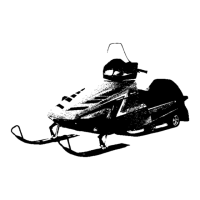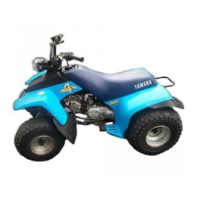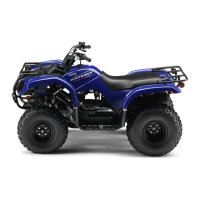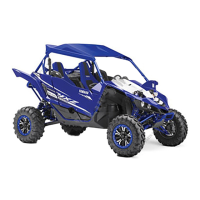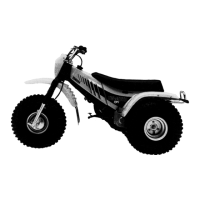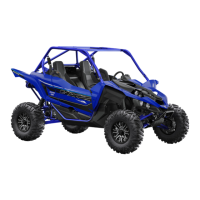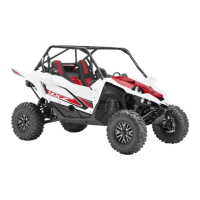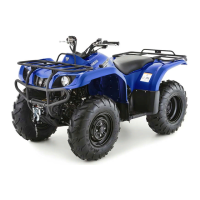
Do you have a question about the Yamaha 1998 BigBear 2x4 YFM350UK and is the answer not in the manual?
| Brand | Yamaha |
|---|---|
| Model | 1998 BigBear 2x4 YFM350UK |
| Category | Offroad Vehicle |
| Language | English |
Highlights critical safety information for ATV operation and owner responsibilities.
Explains the meaning of warning labels like WARNING, CAUTION, and NOTE used throughout the manual.
Details the meaning and placement of various warning labels on the ATV for safety.
Describes load limit labels for carriers, indicating maximum weight capacity for safe loading.
Illustrates and explains shift pattern and drive select lever indicators for transmission control.
Highlights the warning label regarding age restrictions for operating the ATV, specifically for riders under 16.
General safety advice stating ATVs are hazardous and require careful operation and adherence to instructions.
Specifies age restrictions for ATV operation, emphasizing no riders under 16 and supervision for younger riders.
Provides guidance on safe riding, including avoiding public roads and handling slippery surfaces.
Details hazards like water, obstacles, and rough terrain, with instructions on how to avoid accidents.
Warns about hazards of improper fuel handling, including fire and explosion risks during refueling.
Alerts to the danger of exhaust fumes in enclosed areas, which can cause poisoning and death.
Explains how to find the key identification number on the ignition key for ordering new keys.
Shows the location of the VIN on the frame, used for identification and registration purposes.
Indicates the location of the model label on the frame, which contains essential information for ordering parts.
Describes the ON and OFF positions of the main switch and their effect on electrical circuits and starting.
Explains the function of the reverse, neutral, and oil temperature indicator lights on the dashboard.
Provides a flowchart for checking the functionality of the oil temperature indicator light.
Details the speedometer for riding speed and odometers for tracking distance and fuel planning.
Identifies key handlebar controls including lights switch, engine stop switch, and start switch.
Explains the throttle lever's function for speed control and potential hazards associated with its malfunction.
Describes how the speed limiter works and how to adjust it to control top speed.
Details the front brake lever and rear brake pedal/lever operation for stopping the ATV.
Explains how to apply and release the parking brake, warning about improper use.
Describes the operation of the shift pedal for gear changes and the drive select lever for high, low, and reverse.
Explains the procedure for using the recoil starter to start the engine.
Covers the fuel tank cap and fuel cock operation, including reserve fuel positions.
Details the operation of the starter choke for cold engine starting.
Provides instructions on how to remove and install the ATV seat.
Lists maximum load capacities for the storage box and carriers.
Instructs on checking brake levers, pedal, fluid level, and operation before riding.
Guides on checking the fuel level and ensuring sufficient fuel is in the tank.
Details how to check engine oil and final gear oil levels and for leaks.
Emphasizes checking the throttle lever and cable for proper operation and free play.
Covers checking tire pressure, wear, and all fittings and fasteners for security.
Instructs on checking the operation of lights and the battery fluid level.
Step-by-step guide for starting the engine when cold, including choke and fuel cock usage.
Explains how to start a warm engine and the importance of warming up before riding.
Details the operation of the drive select lever for shifting between high, low, and reverse gears.
Provides instructions on how to shift gears, including warnings about improper shifting.
Guides on how to accelerate smoothly and decelerate safely using throttle and brakes.
Explains the critical engine break-in process for new machines to ensure longevity.
Covers proper parking procedures, including securing the machine on slopes.
Advises on safe loading of accessories and cargo, including weight limits and trailer towing.
Introduces the MOTO-4 for utility and recreation, emphasizing familiarization with controls and safety.
Stresses the importance of training, skill development, and good judgement for safe operation.
Reiterates age recommendations and prohibits carrying passengers, explaining the impact on balance.
Lists essential protective gear, including helmets, eye protection, gloves, boots, and long pants.
Warns against operating the ATV under the influence of alcohol or drugs due to impaired judgment and reaction.
Advises on riding through unfamiliar terrain, obstacles, rough, slippery, or loose surfaces.
Provides guidance for safely crossing shallow water, including brake testing after.
Offers advice on riding over rough terrain, emphasizing caution and proper foot placement.
Explains how to handle and recover from sliding or skidding on loose or slippery surfaces.
Details proper techniques for turning, including leaning and weight transfer for stability.
Covers techniques for safely climbing and descending hills, including weight distribution.
Explains how to traverse sloping surfaces and maintain balance.
Instructs owners to keep the manual and tool kit accessible for maintenance and minor repairs.
Presents a detailed schedule for periodic checks, adjustments, and lubrication intervals.
Guides on checking the engine oil level, recommended oil type, and procedures for oil and filter replacement.
Details how to check and replace the final gear oil, including recommended oil and quantities.
Explains how to inspect the spark plug, check its gap, and the recommended torque for installation.
Provides instructions for cleaning the air filter element and case, including notes on lubricant.
Covers carburetor adjustment and idle speed settings, recommending professional service if needed.
Details inspection of front and rear brake shoes, fluid levels, and fluid replacement.
Explains how to adjust the free play of the front brake lever and rear brake pedal.
Guides on adjusting the clutch cable for proper operation.
Covers wheel removal, installation, and tire mounting, including torque specifications.
Instructs on checking battery fluid level, terminal tightness, and proper storage of the battery.
Provides detailed steps for cleaning the ATV, including cautions about water pressure and detergent use.
Outlines procedures for preparing the ATV for storage, including fuel draining, lubrication, and battery care.
Details the warranty period, coverage, and owner's responsibilities for maintaining the machine.
Lists conditions and usage that are not covered by the limited warranty.
Explains the procedure and conditions for transferring the warranty to a new owner.
Provides answers to common questions regarding warranty coverage and service.
Information on contacting customer service and notifying Yamaha of address changes.



